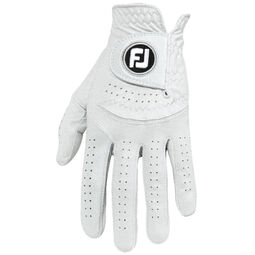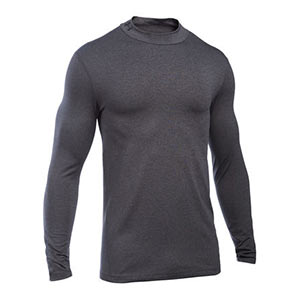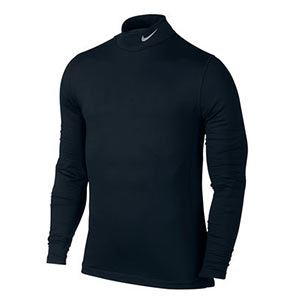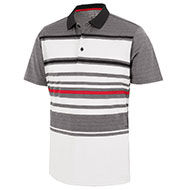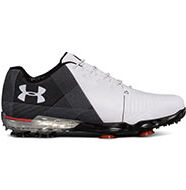Dressing to suit the environment in which you play is some of the best advice a golfer can take on board. Studies have shown that athletes perform better when comfort is optimised, regardless of the weather condition. This applies to anything a person does; golf, running, mountain climbing--and the introduction of new fabric technologies has opened the door for a wider range of technical apparel that’s benefited players in major sports. These new designs have heightened performances from top golf professionals as they tap into these built-in technologies to enhance their game.
The most common apparel for outdoor warmth and comfort is the base layer, which excels by offering a ‘3 Layer Clothing System’ to bring out the best in everything you do on the golf course--and beyond. The 3-Layer Clothing System is made from a combination of fabrics and technology that thrive in any weather condition by allowing top performances without the risk of elemental fatigue such as chill in the bones or overheating from sun. Below is a guide to what makes up the 3 Layer Clothing System, and how it works.
Layer 1: The Base layer
The base layer, or foundation layer, is worn closest to the skin. It eliminates moisture from the skin which natural fibres such as cotton cannot achieve on their own due to having higher absorbency, and wicks them away to keep you cool and dry.
The base layer is compression fitting, as it needs to fit snug over all contours of the body to work efficiently in cold weather and warm conditions. Base layers should provide key ‘wicking’ capabilities to remove moisture from the surface of the skin caused by over exertion and, where cold exists, also have good thermal properties that help maintain the body’s core body temperature.
In warm weather, the base layer can wick moisture away from skin to the outside of clothing where it evaporates quickly to give a cooling effect on the body. Base layers designed for hot weather conditions have no thermal properties, being made from extremely fine fabric.
Compression base layers are widely used in the sports sector to improve performance and recovery when the body is placed under extreme situations in hot and cold weather. Marathon cyclists will wear tight-fitting gear in warm conditions when traversing uphill terrain and rocky environments, while skiers will adopt the same approach when performing on frozen slopes and mountain ranges. These compression-fit garments assist in muscle efficiency and the protection and recovery of core muscle groups, as well as providing a regulated body temperature.
Base layer should be very comfortable with “flat lock seams” to minimise abrasion, and are usually constructed from man-made materials.
Layer 2: The Mid-Layer
Mid-layer apparel is designed to provide considerable thermal insulation or act as transport layer in warm-weather conditions. Generally, the mid-layer is made from loose, weave fabric, and allows for pockets of warm air to be created by the body’s own temperature. The fabric is very fine and lightweight, so that it can continue to carry moisture away from the body quickly and effortlessly for evaporation. Hot weather layers can be worn next to skin as they also wick moisture, resulting in the same responses.
Mid-layers are only effective with a good base layer beneath it, so always ensure that everything worn is supported by the other, and that a team spirit exists between the two apparels. Mid-layers also need to have moisture-wicking to transport perspiration to the outside of the layer for easy evaporation, while the garments are generally lightweight due to the fabrication, and are ideal for mid climate conditions or as a lightweight protective layer used following exertive exercise.
Mid-layers will be susceptible to external weather conditions during play, as wind can penetrate easily into the fabric to replace the warm pockets of air created by the body’s core temperature. Even a light, cool breeze drifting in over the fairway can reduce temperatures by up to 10° and on a 0° day this creates an effect of -10° temperatures on the body. Often the phrase coined for this is the wind chill factor, and avoiding this is easily done by simply purchasing a quality top layer to compliment the rest of your weather-hardened gear.
Which base layer?
Look for these key components when purchasing a base layer:
Style choice
There’s a plethora of options available to golfers when it comes to looking and feeling good on the greens. Zip collars, crew necks, V-necks, mock collars, short or long sleeve--the list goes on. However, the fact is, higher collars will protect the neck area in cold weather, whilst short sleeves are better served for warm weather. Loose-fitting attires and zip-collars provide better ventilation in all conditions.
Warm or cold weather performance
Warmer conditions will require you to wick away moisture from the skin so that it evaporates quickly to keep you feeling cool. In colder weather, it’s time to introduce Thermal protection, which enhances coolness and keeps perspiration away from skin.
Selecting fabrics
It is advisable to avoid wearing cotton fabrics on the greens due to its inability to keep you ventilated, and the restrictions it places on swing momentum. Wool and synthetic are more sustainable, while polyester wicks away moisture and is often used in loosely-fitting garments. Polypropylene requires a closer, bunched in fit to benefit players, so combining the two is a good idea.
Some popular base layers which offer a great level of warmth on the golf course include the Under Armour Coldgear Mock Base Layer, Benross Pro Shell Base Layer, Galvin Green East Base Layer, Nike Golf Hyperwarm Base Layer, Palm Grove Roll Neck Ladies Base Layer, PING Lloyd Base Layer, adidas Golf climawarm Ladies Base Layer and Under Armour ColdGear Compression Mock Base Layer.
Knowing the right fit
Though very tight-fitting, a base layer is designed to ensure you have complete freedom of movement. Raglan style, off the shoulder sleeves, wide openings and good fitting, not over tight collar and cuffs, are always essential; as is the body length.
What’s your sport?
For contact sports, a man-made base layer would be ideal as they offer better fit and performance. Additionally, compression options will support and protect muscles during sport.
Sports such as golf, cycling, climbing or hiking means that a wool option is fine but again the man-made alternatives transcend the sport you are practising and offer a real feeling of leisure that wool cannot match.
Avoiding rubbing and other discomforts
Golf can be a time-consuming sport, and it’s likely that you will be wearing the base layer for long periods. The intricate design imposed by base layers is that they are usually made to fit tight to the body as comfort is critical for its performance. Quality base layers should minimise the risk of rubbing by having well sewn ‘flat’ stitched seams that eliminate possible seam abrasion. When competing in contact sports especially where pulling is likely to occur, selecting a base layer with reinforced FlatLock seams will allow stretching along with the garment so no damage to the attire can be caused.
Natural or synthetic – which is best for you?
This choice is up to you. Different base layers made from specific materials will give better performances than others.
Favoured by many athletes as a natural base layer that remains odour free after days of wear is merino wool. Derived from merino sheep’s wool, it is a natural and renewable source of fabric. Merino fibres are particularly fine and woven in such a way as to avoid that terrible itchy, scratchy feeling often associated with wool in the past. And unlike synthetics, which wick moisture away from skin, merino does the polar opposite as it has the uncanny ability to absorb up to 3 times its own weight in liquid, thus keeping you dry by keeping moisture far from skin. Wool is the ideal choice for any cold weather activities. Created by nature and used for outdoor pursuits, golf purists find plenty of success in utilising this material in their attires.
Baselayer compression types
Each base layers have different compression types, so with so many brands creating better, more advanced attires, it can be challenging to know exactly which base layer is best for you.
High intensity sports & recovery
High intensity Compression is designed to offer support to the core muscle groups in an athlete’s body, and hones in on certain areas to help specific muscles and susceptible areas. Also, used in travel and recovery compression where post exercise support is recommended to give the muscles time after a heavy workout to repair and sooth, whilst also reducing fatigue in athletes who have walked long-haul distances.
Sports compression high support
A compression attire with an even body-wide high compression ratio, high support sport compression is designed to help athletes undertaking intense contact sports or endurance work. The production of toxins such as lactic acid is high during intense workouts and therefore speeding up the elimination of these toxins from the body produces higher levels of activity. High muscle support is present all-round and significantly reduces muscle vibration to improve overall athletic performance.
Sports performance compression
This is the largest sector for sportsmen and women requiring compression. All round quality sports compression fabrication provides incredible all-over support for the muscles and reduces muscle vibration, increased blood flow in the body and aids the reductions of toxins caused by intense levels of activity. About 90% of the compression requirements fall into this category.
Every compression attire offers athletes some level of benefit when it comes to muscle support and increased performances. Overall, though, it is down to the person which brand they trust and the Compression ratio and level of intensity required.
Baselayer compression benefits
There are three main benefits that a base layer offers when acting on the body. Baselayer garments regulate body temperature, compress core muscles and aid recovery. They are not simply for top athletes though and performance base layers benefits everyone from the seasoned pros to the part-timer.
Compression base layers are state-of-the-art garments designed to regulate body temperature and reduce the build-up of lactic acid by compressing the muscles before, during and after physical exercise. Scientists have shown that in reducing the build up of lactic acid during and following exertion, the recovery rate of an athlete is enhanced greatly and their susceptibility to injury becomes reduced. By compressing the muscle groups during and after exercise, it helps to protect them from potential damage to make athletic performances better.
Check out the full range of golf base layers today, or take a look at all the top brands we stock which have a great selection of baselayers available, including Under Armour, Galvin Green, Benross, Puma.

